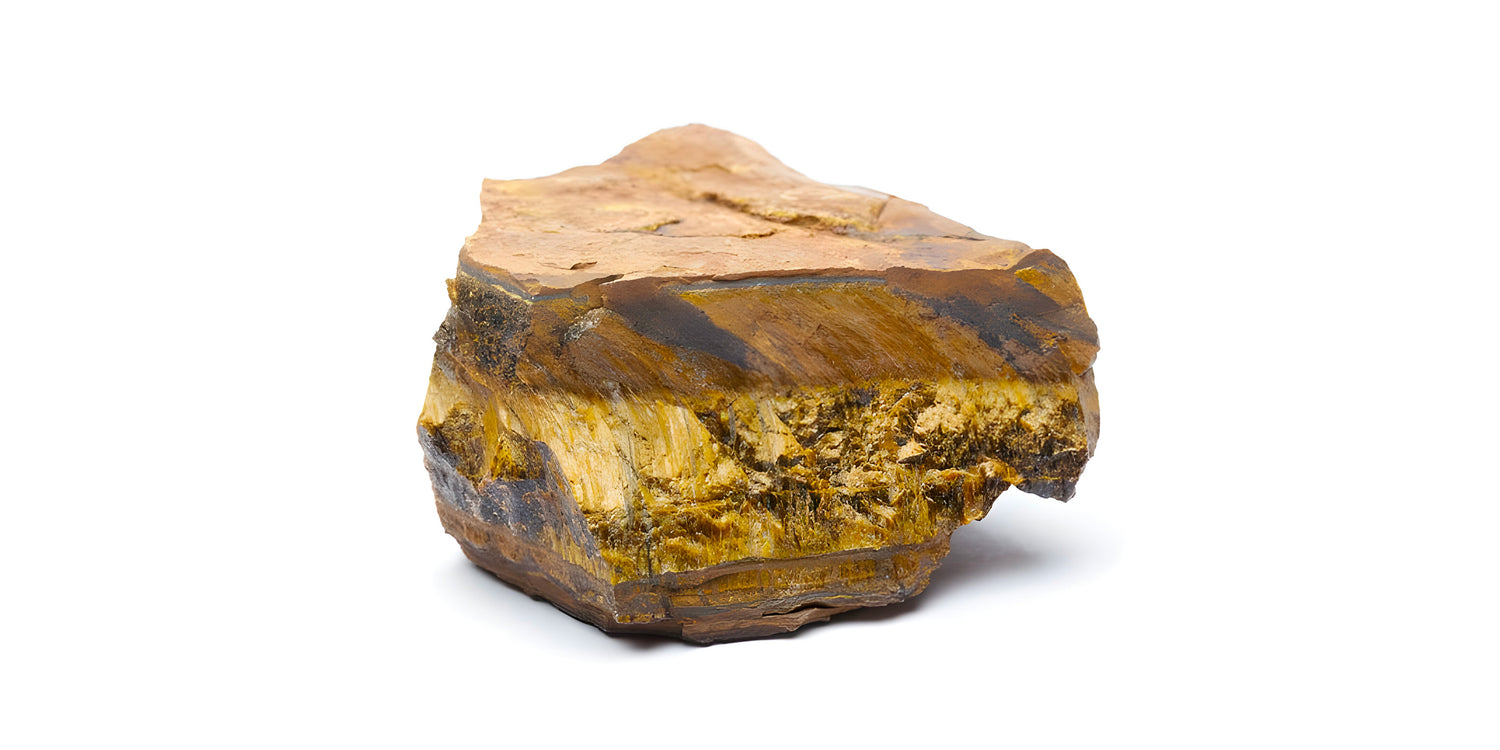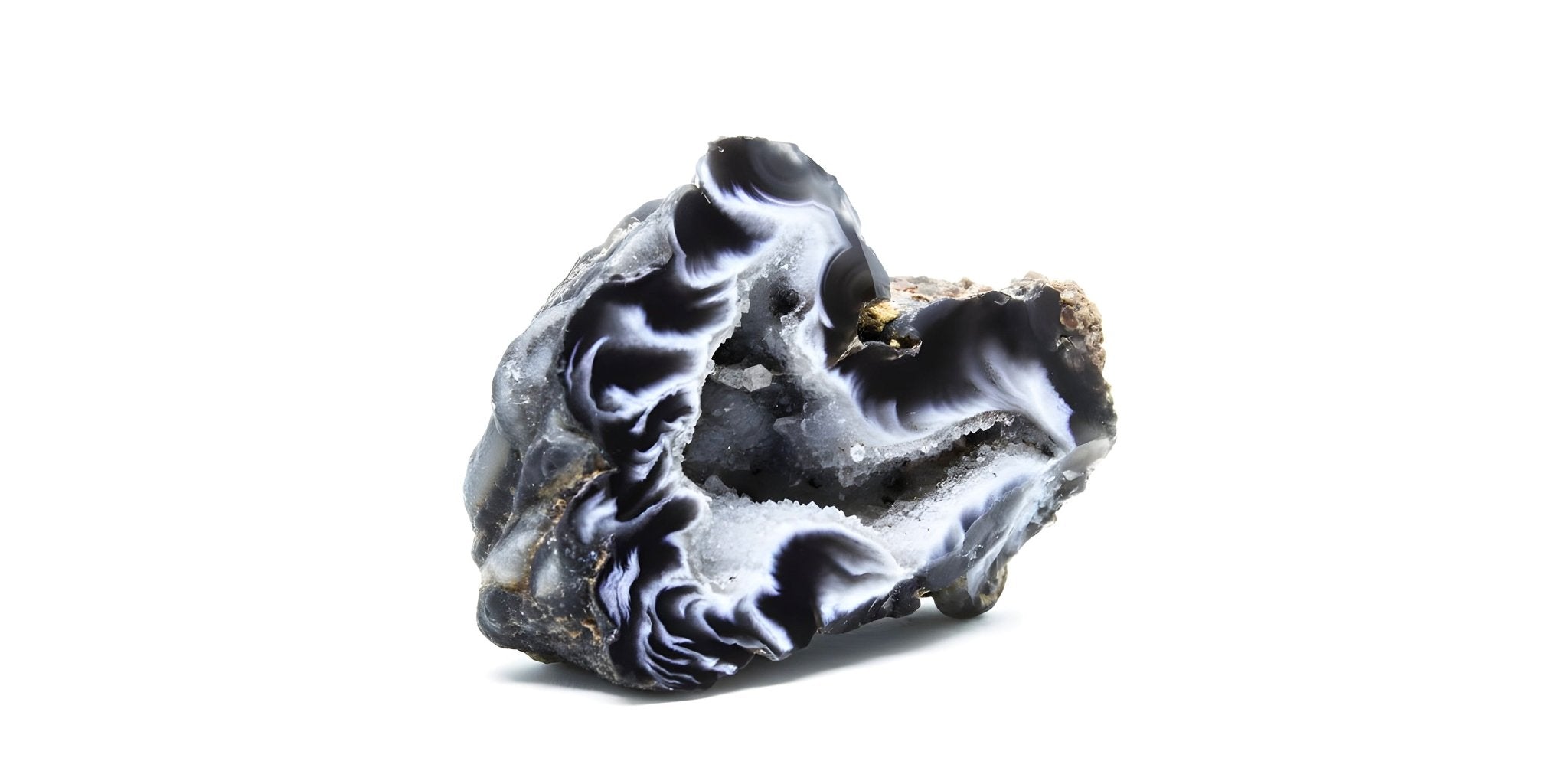Tiger's Eye Stone Identity Sheet
- Origin of the name: Tiger's Eye gets its name from its shine, reminiscent of a tiger's eye, with golden and brown highlights that seem to follow the observer's gaze, just like the watchful eye of the great feline.
- Group: Quartz (Silicates).
- Chemical composition: SiO2 (silicon dioxide), with inclusions of crocidolite (blue asbestos) that have been partially or completely replaced by silicon.
- Crystal system: Rhombohedral, a variant of the trigonal crystal structure.
- Hardness: Around 7 on the Mohs scale, making it a fairly durable stone for use in jewelry.
- Deposits: Mainly in South Africa, Australia, Burma (Myanmar), India, Namibia, and the United States.
- Color(s): Alternating golden to brown bands, with shimmering reflections due to its fibrous structure.
- Chakras: Primarily associated with the solar plexus chakra (Manipura), tiger's eye is renowned for strengthening self-confidence and personal power.
Where does the name Tiger's Eye come from?
Tiger's eye, with its shimmering reflections and golden bands on a brown background, is a fascinating stone whose appearance is as mysterious as the name it bears. This evocative name is no accident and draws its origins from the rich tapestry of history and nature itself.
A Captivating Visual Heritage
The origin of the name "tiger's eye" is directly linked to the unique visual aspect of this gem. The stone's reflections, which range from golden to brown depending on the viewing angle, are reminiscent of the piercing gaze and majesty of a tiger. This resemblance is not merely a coincidence but the result of its composition and crystalline structure, which diffract light to create this specific shimmering effect. Thus, the name "tiger's eye" immediately evokes the image of a tiger's gaze, intense and mesmerizing.
Symbolism and Meaning
Beyond its mere appearance, the name "tiger's eye" carries significant symbolic weight. Tigers are creatures that symbolize strength, courage, and protection in many cultures around the world. By naming this stone after one of the most iconic and respected animals, its qualities are intuitively associated with protection, clairvoyance, and insight. Thus, this name reflects not only the physical aspect of the gem but also its attributed virtues, such as offering protection and self-confidence to its wearer.
A Connection with Nature
The designation of tiger's eye as a precious stone strengthens our connection with the natural world. By naming this stone after an animal, we acknowledge the importance of nature in our lives and how it can influence, even enhance, our well-being. This highlights a belief deeply rooted in tradition and spirituality: that natural elements, including minerals and animals, possess energies and meanings that can affect us in profound and positive ways.
What is the history of the Tiger's Eye stone?
Tiger's Eye, this shimmering stone that captivates the eye and the imagination, holds a rich history that spans continents and civilizations. Far beyond its aesthetic appeal, Tiger's Eye is imbued with symbolism and mysticism, and has played various roles in cultural and spiritual practices throughout history.
Ancient Origins
The use of Tiger's Eye dates back thousands of years. The ancient Egyptians were among the first to recognize the value of this stone, not only for its beauty but also for the protective powers they attributed to it. They used it to craft amulets and jewelry intended to protect the wearer in the afterlife, as well as to equip the eyes of their gods' statues, believing this would grant them a protective vision.
The Warrior's Stone
In ancient times, Tiger's Eye was also considered a stone of war. Roman warriors wore Tiger's Eye talismans, believing they granted courage and protection in battle. This belief was rooted in the stone's appearance, whose reflections resemble a watchful eye, ready to anticipate and ward off any threat. This use highlights the role of Tiger's Eye as a symbol of inner strength and vigilance.
A Stone of Trade and Discovery
In the Middle Ages, Tiger's Eye gained popularity not only as a protective object but also as a prized gemstone in trade. At that time, it symbolized wealth and was often exchanged or given as a gift. The trade routes established between East and West facilitated the spread of Tiger's Eye, contributing to its status as a precious stone and its renown in different cultures.
Spiritual and Cultural Symbolism
In many cultures, Tiger's Eye is associated with the earth, the sun, and the ability to see beyond appearances to uncover hidden truths. In spiritual traditions, this stone is often used to balance yin and yang, as well as to stimulate the flow of energy throughout the body. Its ability to promote grounding and provide mental clarity makes it a precious stone in meditation practices and in the pursuit of personal development.
Tiger's Eye in the Modern World
Today, Tiger's Eye continues to captivate with its golden hues and deep reflections. It is widely used in jewelry for its unique beauty, but also in crystal healing for its protective, healing, and energy-balancing properties. Its presence in popular culture and modern spiritual practices attests to the enduring appeal and significance it has held throughout the ages.
What is the origin and composition of the stone Tiger's Eye?
Tiger's eye, this captivating gemstone with golden reflections and dark bands, draws its charm not only from its mesmerizing appearance but also from its unique geological origin and chemical composition. Exploring the origin and composition of tiger's eye offers us a fascinating insight into how nature can create wonders of incomparable beauty.
Geological Origin
Tiger's eye is mainly formed from the transformation of crocidolite, a blue asbestos, which, under alteration, is gradually replaced by quartz while retaining its fibrous structure. This process of pseudomorphism, where one mineral replaces another while keeping the original shape of the first, gives tiger's eye its characteristic silky texture and shimmering reflections. The specific conditions required for this transformation are relatively rare, making tiger's eye a truly special stone.
Chemical Composition
Chemically, tiger's eye is mainly composed of silicon dioxide (SiO2), which places it in the quartz family. The presence of iron in altered crocidolite gives it shades ranging from golden yellow to dark brown. The fibrous structure of crocidolite, preserved during transformation, is responsible for the chatoyancy effect, or cat's eye effect, that characterizes this stone. This effect is due to the reflection of light on the parallel fibers included in the stone.
Main Deposits
The main deposits of tiger's eye are found in South Africa, Australia, India, Myanmar (Burma), Namibia, and the United States. South Africa is particularly renowned for its high-quality tiger's eye deposits, where the stone is extracted under conditions that preserve its natural beauty and unique qualities.
Variations and Colors
Although tiger's eye is generally recognized by its golden and brown bands, the stone can display a wide range of color variations depending on the exact mineral composition and the degree of crocidolite alteration. In addition to the traditional shades, there are variants such as hawk's eye, blue-gray, resulting from less iron oxidation, and bull's eye, red-brown, resulting from a greater presence of oxidized iron.
What are the properties of Tiger's Eye stone (physical and psychic)?
Tiger's eye, this gemstone with golden reflections and deep luster, is much more than a simple precious stone. It is recognized across cultures for its physical and psychic properties, offering its wearer protection, balance, and clarity. Let us take a closer look at the multidimensional benefits of this fascinating stone.
Physical Benefits
On a physical level, tiger's eye is renowned for its strengthening and healing properties. It is often used to stimulate the immune system, helping the body defend itself against minor illnesses and recover more quickly. This stone is also credited with the ability to improve night vision and reduce eye-related issues, in harmony with its name, which evokes the feline's visual clarity.
Additionally, tiger's eye can help relieve pain, especially those related to muscle tension and joint problems. Its ability to warm the body makes it an ally against cold and flu symptoms, as well as for people suffering from chronic chills.
Psychic and Emotional Benefits
On a psychic and emotional level, tiger's eye is a grounding stone that encourages balance between mind and body. It promotes a clearer perception of situations, helping to dispel fear and anxiety. By strengthening self-confidence and fostering a more objective outlook, tiger's eye helps overcome periods of doubt and uncertainty.
This stone is also known for stimulating willpower and determination. It encourages its wearer to act with integrity and to use their personal power wisely. In moments of decision, tiger's eye provides the clarity needed to distinguish truth from falsehood and to recognize one's own inner resources.
Boosting Creativity and Focus
Tiger's eye is a catalyst for creativity. By removing mental blockages, it frees the flow of ideas and encourages creative expression. For students and professionals, this stone enhances concentration and helps maintain focus on tasks and goals, making it an excellent tool for work and study.
Protection and Positive Energy
One of the most renowned virtues of tiger's eye is its ability to protect against negative energies. Traditionally worn as a talisman, it creates an energetic shield around its wearer, warding off ill will and potential dangers. By absorbing negative energies, tiger's eye fosters an environment of positivity and well-being.














